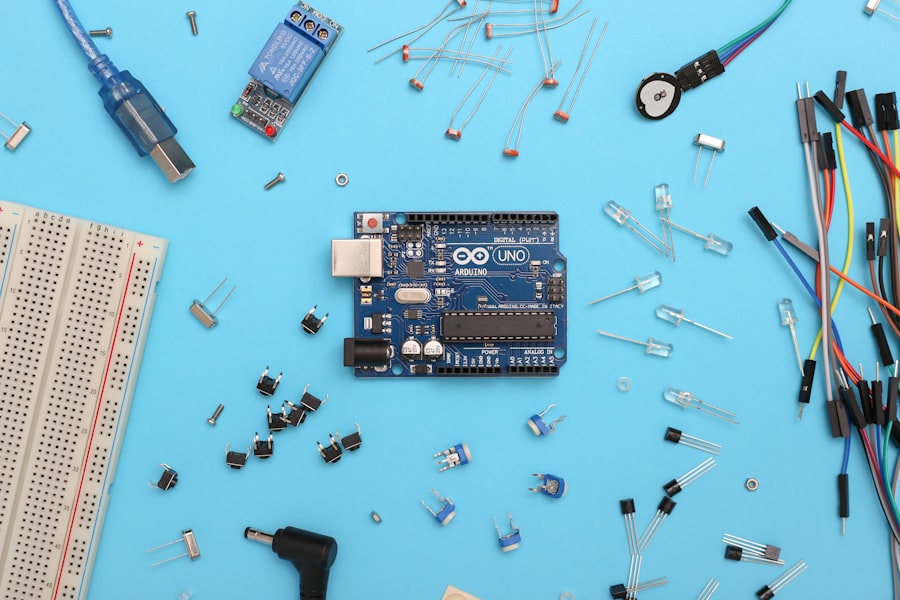
Electronics installation services play a crucial role in today’s technology-driven world. From setting up home entertainment systems to installing security cameras, these services ensure that electronic devices are properly installed and functioning optimally. In this article, we will explore the basics of electronics installation services, the importance of proper wiring and cable management, choosing the right tools and equipment for the job, essential safety practices, troubleshooting common installation issues, best practices for mounting and securing electronics, tips for working with different types of electronics, testing and verifying installations, building long-term relationships with customers, and staying up-to-date with the latest technologies and trends.
Understanding the Basics of Electronics Installation Services
Electronics installation services refer to the process of setting up and connecting electronic devices in a safe and efficient manner. This can include everything from installing televisions and sound systems to setting up home automation systems and security cameras. These services are typically provided by professionals who have the knowledge and expertise to handle complex installations.
There are various types of electronics that require installation services. Some common examples include:
1. Home entertainment systems: This includes televisions, surround sound systems, gaming consoles, and media players.
2. Security systems: This includes surveillance cameras, alarm systems, and access control systems.
3. Home automation systems: This includes smart thermostats, lighting control systems, and voice assistants.
4. Networking equipment: This includes routers, switches, and modems.
Proper installation of these devices is essential to ensure optimal performance and functionality.
The Importance of Proper Wiring and Cable Management
Wiring and cable management play a crucial role in electronics installation services. Proper wiring ensures that all devices are connected correctly and that signals are transmitted efficiently. It also helps prevent signal interference and reduces the risk of electrical hazards.
One common mistake in wiring is using incorrect cable lengths or not properly organizing cables. This can lead to messy installations that are difficult to troubleshoot and maintain. It is important to plan the wiring layout in advance and use appropriate cable management techniques, such as cable trays, zip ties, and cable clips, to keep everything organized and tidy.
Another common mistake is not labeling cables. This can make it challenging to identify which cable is connected to which device, especially in complex installations. Labeling cables can save time and effort during troubleshooting or when making changes to the setup.
Choosing the Right Tools and Equipment for the Job
Having the right tools and equipment is essential for a successful electronics installation. Some essential tools for electronics installation services include:
1. Screwdrivers: Different types of screwdrivers, such as Phillips and flathead, are needed for various tasks, such as removing screws from devices or mounting brackets.
2. Wire cutters and strippers: These tools are used to cut and strip wires to the appropriate length.
3. Crimping tool: This tool is used to attach connectors to the ends of wires.
4. Cable tester: A cable tester is used to check the continuity and integrity of cables.
When choosing tools and equipment, it is important to consider factors such as quality, durability, and compatibility with the devices being installed. Investing in high-quality tools can save time and effort in the long run.
Essential Safety Practices for Electronics Installation
Safety should always be a top priority when performing electronics installation services. Working with electricity can be dangerous if proper precautions are not taken. Some important safety practices include:
1. Turn off power: Before starting any installation work, it is crucial to turn off the power to the area where the installation will take place. This helps prevent electrical shocks or short circuits.
2. Use personal protective equipment (PPE): Wearing appropriate PPE, such as safety glasses and gloves, can protect against potential hazards.
3. Follow manufacturer’s instructions: Always read and follow the manufacturer’s instructions for the devices being installed. This ensures that the installation is done correctly and safely.
4. Avoid overloading circuits: Overloading circuits can lead to electrical fires. It is important to distribute the load evenly across circuits and not exceed their maximum capacity.
By following these safety practices, electronics installation professionals can ensure a safe working environment for themselves and their clients.
Troubleshooting Common Installation Issues

Even with proper planning and execution, installation issues can still arise. It is important to be prepared to troubleshoot and resolve these issues efficiently. Some common installation issues include:
1. Poor signal quality: This can occur in audio or video systems and may be caused by improper cable connections or signal interference. Checking and reseating cables, as well as using shielded cables, can help resolve this issue.
2. Power supply problems: Devices may not power on or may experience intermittent power issues. This can be caused by faulty power outlets or power supplies. Testing the power source and replacing faulty components can help resolve this issue.
3. Network connectivity issues: In networking installations, connectivity problems may arise due to incorrect IP configurations or faulty network equipment. Checking network settings and replacing faulty equipment can help resolve this issue.
When troubleshooting installation issues, it is important to approach the problem systematically and methodically. Start by identifying the symptoms, then isolate the potential causes, and finally test and implement solutions.
Best Practices for Mounting and Securing Electronics
Proper mounting and securing of electronics is essential to ensure their stability and longevity. Some best practices for mounting and securing different types of electronics include:
1. TVs and monitors: Use appropriate wall mounts or stands that are designed to support the weight of the device. Follow the manufacturer’s instructions for proper installation.
2. Speakers: Mount speakers securely to walls or ceilings using appropriate brackets or mounts. Ensure that they are positioned correctly for optimal sound quality.
3. Security cameras: Install security cameras in locations that provide optimal coverage and visibility. Use weatherproof enclosures and secure mounting brackets to protect the cameras from the elements and tampering.
4. Networking equipment: Mount networking equipment, such as routers and switches, in a well-ventilated area to prevent overheating. Use rack-mountable enclosures or wall mounts for proper organization and accessibility.
By following these best practices, electronics can be securely mounted and protected from damage.
Tips for Working with Different Types of Electronics
Different types of electronics have unique installation requirements. Here are some tips for working with different types of electronics:
1. Home entertainment systems: When setting up a home entertainment system, consider factors such as room acoustics, speaker placement, and cable management. Use high-quality cables and connectors for optimal audio and video performance.
2. Security systems: Plan the placement of security cameras strategically to cover all areas of interest. Ensure that the cameras are positioned at the correct angle for optimal surveillance.
3. Home automation systems: When installing home automation systems, ensure compatibility between devices and follow the manufacturer’s instructions for proper integration. Test the system thoroughly to ensure all devices are functioning correctly.
4. Networking equipment: When setting up a network, consider factors such as network topology, cable length limitations, and security protocols. Use high-quality networking equipment to ensure reliable connectivity.
By understanding the unique requirements of different types of electronics, installation professionals can provide efficient and effective services to their clients.
How to Test and Verify Your Installation
Testing and verifying an installation is crucial to ensure that everything is functioning correctly. Some methods for testing and verifying an installation include:
1. Signal testing: Use appropriate tools, such as cable testers or signal analyzers, to check the integrity of cables and signal quality. This can help identify any issues with connectivity or signal loss.
2. Functionality testing: Test each device individually to ensure that all features and functions are working as intended. This can include testing audio and video quality, network connectivity, and automation functions.
3. System integration testing: If multiple devices are being installed as part of a system, test the integration between the devices to ensure seamless operation. This can include testing communication between devices and verifying that automation functions work correctly.
By thoroughly testing and verifying an installation, any potential issues can be identified and resolved before handing over the project to the client.
Building Long-Term Relationships with Customers
Building long-term relationships with customers is essential for the success of electronics installation services. Satisfied customers are more likely to recommend your services to others and become repeat customers. Some tips for building and maintaining customer relationships include:
1. Excellent customer service: Provide prompt and friendly customer service throughout the installation process. Address any concerns or questions the customer may have and ensure their satisfaction.
2. Follow-up support: Offer post-installation support to address any issues or questions that may arise after the installation is complete. This can help build trust and loyalty with customers.
3. Regular communication: Stay in touch with customers through newsletters, emails, or social media updates. This keeps them informed about new products or services and shows that you value their business.
4. Ask for feedback: Request feedback from customers to understand their experience and identify areas for improvement. Use this feedback to enhance your services and exceed customer expectations.
By focusing on building strong relationships with customers, electronics installation professionals can establish a loyal customer base and grow their business.
Staying Up-to-Date with the Latest Technologies and Trends
Staying up-to-date with the latest technologies and trends is crucial in the rapidly evolving field of electronics installation services. By staying informed, professionals can offer cutting-edge solutions to their clients and stay ahead of the competition. Some ways to stay up-to-date include:
1. Attend industry conferences and trade shows: These events provide opportunities to learn about new technologies, network with industry professionals, and stay informed about the latest trends.
2. Continuous education and training: Take advantage of training programs and certifications offered by manufacturers or industry organizations. This ensures that professionals have the knowledge and skills to work with the latest technologies.
3. Read industry publications and websites: Stay informed by regularly reading industry publications, websites, and blogs that cover the latest developments in electronics installation.
4. Join professional organizations: Joining professional organizations can provide access to resources, networking opportunities, and educational events that keep professionals up-to-date with industry trends.
By staying up-to-date with the latest technologies and trends, electronics installation professionals can provide innovative solutions to their clients and remain competitive in the market.
Electronics installation services are essential in today’s technology-driven world. Proper wiring and cable management, choosing the right tools and equipment, following essential safety practices, troubleshooting common installation issues, best practices for mounting and securing electronics, tips for working with different types of electronics, testing and verifying installations, building long-term relationships with customers, and staying up-to-date with the latest technologies and trends are all crucial aspects of providing high-quality installation services. By understanding these key points and implementing them in their work, electronics installation professionals can ensure successful installations that meet the needs of their clients.
